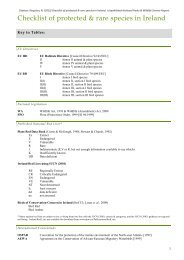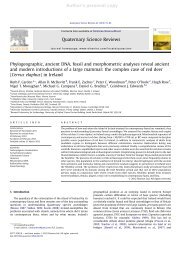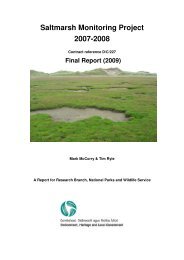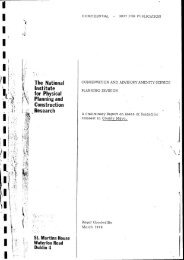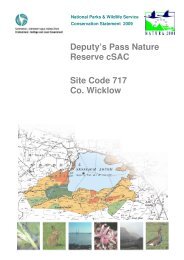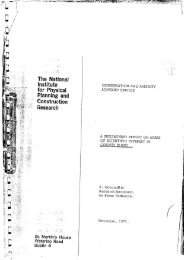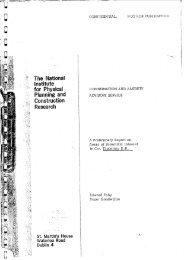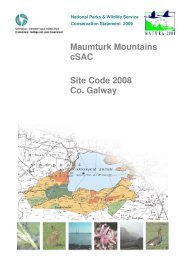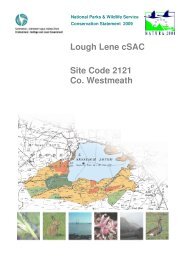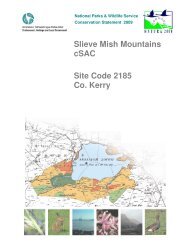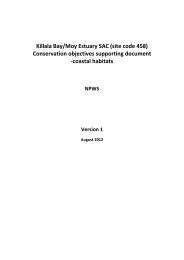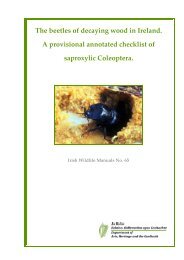The Role of Kelp in the Marine Environment - National Parks ...
The Role of Kelp in the Marine Environment - National Parks ...
The Role of Kelp in the Marine Environment - National Parks ...
Create successful ePaper yourself
Turn your PDF publications into a flip-book with our unique Google optimized e-Paper software.
macrophyte wrack and <strong>the</strong> abundance <strong>of</strong> wrack-associated <strong>in</strong>vertebrate fauna<br />
(Dugan et al., 2003).<br />
Observations <strong>in</strong> Ireland and studies across <strong>the</strong> world <strong>the</strong>refore suggest that many<br />
shorebird species are dependent on kelp wrack habitats. However, wrack deposits are<br />
rarely monospecific and o<strong>the</strong>r macrophyte wrack (e.g., Fucus spp., Ascophyllum<br />
nodosum) may be equally as important (e.g., Carss & Elston, 2003) <strong>in</strong> provid<strong>in</strong>g this<br />
important forag<strong>in</strong>g habitat.<br />
In addition to shorebirds, kelp wrack is used as a forag<strong>in</strong>g habitat by many terrestrial<br />
birds <strong>in</strong>clud<strong>in</strong>g crows, pipits, wagtails and starl<strong>in</strong>gs (Ferns, 1992; A. Walsh & O.<br />
Merne, pers.comm).<br />
<strong>Kelp</strong> wrack also benefits birds via its role <strong>in</strong> provid<strong>in</strong>g organic matter to coastal<br />
mar<strong>in</strong>e ecosystems. Research <strong>in</strong>to trophic relationships between subtidal and<br />
<strong>in</strong>tertidal ecosystems have demonstrated strong l<strong>in</strong>ks between subtidal primary<br />
producers (<strong>in</strong>clud<strong>in</strong>g kelp and o<strong>the</strong>r macrophytes) and <strong>in</strong>tertidal consumers such as<br />
<strong>in</strong>vertebrates. <strong>Kelp</strong> detritus contributes a large proportion <strong>of</strong> <strong>the</strong> particulate organic<br />
matter <strong>in</strong>puts to both rocky and sandy shores and previous research has highlighted its<br />
importance for higher trophic levels such as <strong>in</strong>vertebrate consumers (secondary<br />
production) (e.g., Mann, 1973; Dugg<strong>in</strong>s et al., 1989). Previous studies have shown<br />
that growth rates <strong>of</strong> benthic suspension feeders (e.g., Mussels Mytilus edulis) are<br />
higher <strong>in</strong> areas with extensive kelp forests (Dugg<strong>in</strong>s et al., 1989) although Soares et<br />
al. (1996) found a negative relationship between <strong>the</strong> amount <strong>of</strong> <strong>in</strong>tertidal stranded<br />
kelp and <strong>the</strong> abundance <strong>of</strong> <strong>the</strong> Wedge Clam Donax serra. Bustamanate & Branch<br />
(1996) suggested that benthic <strong>in</strong>tertidal consumers (<strong>in</strong>vertebrates) relied heavily on<br />
<strong>in</strong>puts from kelp forests and that kelp-derived detritus may regulate <strong>in</strong>vertebrate<br />
populations and community structure. As birds are higher consumers with<strong>in</strong> this<br />
trophic pathway, <strong>the</strong>y will <strong>the</strong>refore benefit <strong>in</strong>directly from <strong>the</strong> <strong>in</strong>puts <strong>of</strong> kelp detritus<br />
ma<strong>in</strong>ta<strong>in</strong><strong>in</strong>g populations <strong>of</strong> <strong>in</strong>vertebrate prey. <strong>The</strong> beneficial effects for birds will<br />
<strong>the</strong>refore be longer last<strong>in</strong>g than that <strong>of</strong> <strong>the</strong> physical presence <strong>of</strong> <strong>the</strong> kelp wrack habitat<br />
itself.<br />
42



